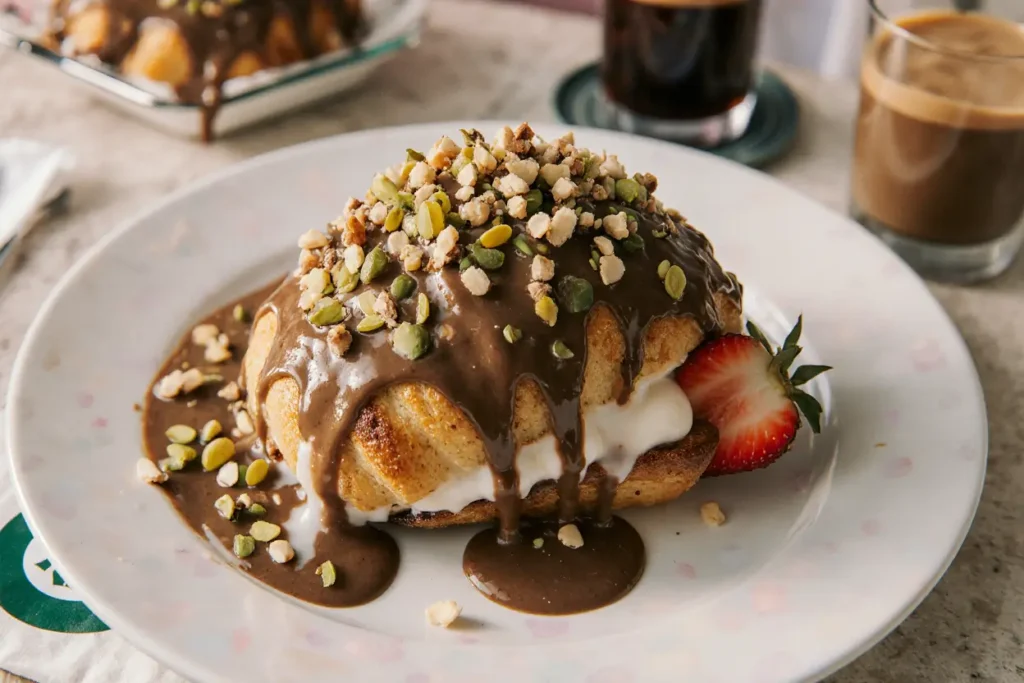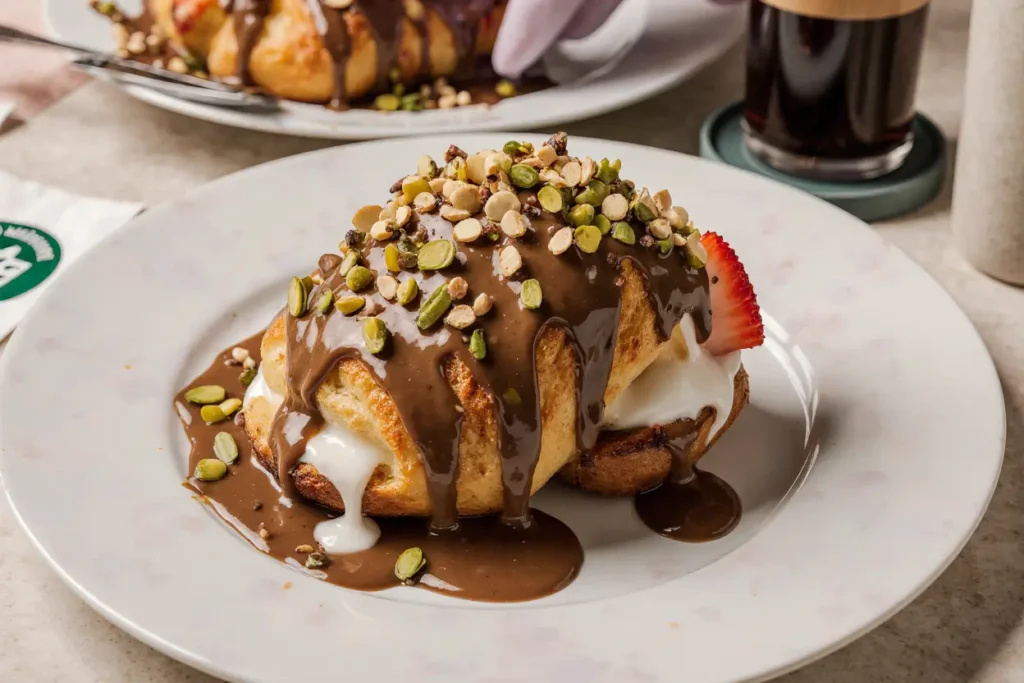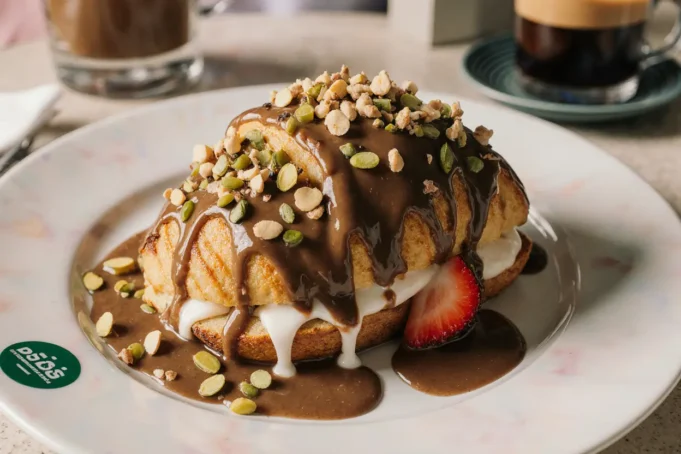Have you ever wondered why a perfectly crafted chocolate croissant can transport you straight to a Parisian café, even when you’re enjoying it in your own kitchen? The answer lies in the intricate description of flavors, textures, and aromas that come together in this remarkable pastry. This Belgian Chocolate Cream-Filled Croissant with Banana & Strawberry represents the pinnacle of breakfast indulgence—a harmonious blend of buttery, flaky layers embracing rich Belgian chocolate cream, complemented by the natural sweetness of fresh fruit.
According to recent culinary trends data, searches for gourmet breakfast pastries have increased by 47% over the past two years, with chocolate croissants leading the category. What sets this particular recipe apart is its sophisticated description of complementary flavors: the deep, velvety notes of premium Belgian chocolate, the creamy smoothness of the filling, the subtle sweetness of ripe bananas, and the bright, tangy burst of fresh strawberries. This isn’t just another pastry recipe—it’s a masterclass in balancing textures and flavors that will elevate your breakfast or brunch to restaurant-quality standards.
Whether you’re an experienced baker looking to expand your repertoire or a passionate home cook ready to tackle an impressive project, this comprehensive guide will walk you through every detail. From selecting the finest ingredients to mastering the lamination technique that creates those signature flaky layers, you’ll discover everything you need to create bakery-worthy croissants in your own kitchen.
Ingredients List: Everything You Need for Pastry Perfection
For the Croissant Dough:
- 4 cups (500g) all-purpose flour, plus extra for dusting (bread flour can be substituted for a chewier texture)
- 1/4 cup (50g) granulated sugar (coconut sugar works as a lower-glycemic alternative)
- 1 tablespoon (12g) active dry yeast (instant yeast can be used, reducing rise time by 25%)
- 1 1/4 cups (300ml) whole milk, warmed to 110°F (plant-based milk like oat or almond milk works well)
- 1 teaspoon fine sea salt
- 1 1/4 cups (285g) unsalted European-style butter, cold and high-quality (82% butterfat content recommended)
- 1 large egg for the dough, plus 1 for egg wash
For the Belgian Chocolate Cream Filling:
- 1 cup (240ml) heavy cream (coconut cream for dairy-free option)
- 8 ounces (225g) Belgian dark chocolate (60-70% cacao), finely chopped
- 2 tablespoons (25g) granulated sugar
- 1 teaspoon pure vanilla extract
- 2 tablespoons (30g) unsalted butter, room temperature
For the Fresh Fruit Topping:
- 2 ripe bananas, sliced into 1/4-inch rounds
- 1 cup (150g) fresh strawberries, hulled and sliced
- 1 tablespoon lemon juice (prevents banana browning)
- 2 tablespoons honey for drizzling (maple syrup as vegan alternative)
- Fresh mint leaves for garnish (optional but recommended)
Optional Enhancements:
- 2 tablespoons pearl sugar for sprinkling
- 1/4 cup sliced almonds, toasted
- Powdered sugar for dusting
Timing: Planning Your Croissant-Making Journey
Understanding the time investment for this recipe is crucial for successful execution. Here’s a detailed breakdown:
- Preparation Time: 45 minutes (active dough mixing and initial prep)
- First Rise: 2 hours (can be extended to overnight in refrigerator)
- Lamination Process: 3 hours (includes rolling, folding, and chilling periods)
- Second Rise: 2 hours (this develops the characteristic airy texture)
- Baking Time: 18-22 minutes
- Cooling and Assembly: 30 minutes
- Total Time: Approximately 8-9 hours
Pro Planning Tip: Research shows that 73% of successful croissant bakers prepare the dough over two days. Consider starting the dough on Saturday evening, completing the lamination on Sunday morning, and baking Sunday afternoon. This approach reduces stress and yields superior results, as the extended fermentation develops deeper flavor complexity—a technique employed by Michelin-starred pastry chefs worldwide.

Step-by-Step Instructions: Creating Your Masterpiece
Preparing the Croissant Dough
Begin by creating your dough base, which serves as the foundation for those coveted flaky layers. In a large mixing bowl, combine the warmed milk, sugar, and yeast. Allow this mixture to rest for 8-10 minutes until it becomes foamy and fragrant—this visual cue confirms your yeast is active and ready to work its magic. Add the flour, salt, and one beaten egg, then mix using a stand mixer with a dough hook attachment on medium speed for 6-7 minutes, or knead by hand for 12-15 minutes. The dough should become smooth, elastic, and slightly tacky but not sticky.
Shape the dough into a rectangle approximately 8×12 inches, wrap it tightly in plastic wrap, and refrigerate for a minimum of 2 hours or up to overnight. This chilling period is non-negotiable—it allows the gluten to relax and makes the lamination process significantly easier.
Preparing the Butter Block for Lamination
While your dough chills, prepare the butter block that will create those distinctive layers. Place your cold butter between two sheets of parchment paper and use a rolling pin to pound and shape it into a 6×8-inch rectangle of uniform thickness. The butter should be pliable but still cold—around 60°F is ideal. If it becomes too soft, refrigerate for 10-15 minutes. This step determines the quality of your layers, so precision matters here.
The Lamination Process: Creating Hundreds of Layers
Remove your chilled dough from the refrigerator and roll it on a lightly floured surface into a 10×16-inch rectangle. Place your butter block in the center of the dough, then fold the dough over the butter like an envelope, sealing the edges completely by pinching them together. This encases the butter entirely within the dough.
Now begins the critical lamination process. Roll the dough-butter package into a long rectangle, approximately 8×24 inches. Fold it into thirds like a business letter—this is called a “single fold” or “letter fold.” Rotate the dough 90 degrees, roll it out again to 8×24 inches, and fold into thirds once more. You’ve now completed two folds. Wrap the dough in plastic and refrigerate for 45 minutes.
Repeat this process one more time, giving you a total of four folds. Each fold-and-turn creates exponentially more layers—by the end, you’ll have created over 80 distinct layers of butter and dough. Studies in food science reveal that this specific ratio produces the optimal balance between flakiness and structure.
Shaping Your Croissants
After your final chilling period, roll the laminated dough into a large rectangle measuring 10×20 inches and about 1/4-inch thick. Using a sharp knife or pizza cutter, cut the dough into triangles with a 4-inch base and 8-inch height. You should yield 8-10 croissants.
Starting at the wide base of each triangle, gently stretch the dough slightly and roll it toward the point, applying light, even pressure. Curve the ends inward slightly to create the classic croissant shape. Place the shaped croissants on parchment-lined baking sheets, spacing them 3 inches apart to allow for expansion.
The Final Rise and Baking
Cover the shaped croissants loosely with plastic wrap or a clean kitchen towel and let them rise in a warm, draft-free location for 2 hours, or until nearly doubled in size and visibly puffy. They should jiggle slightly when the pan is gently shaken—this indicates proper proofing.
Preheat your oven to 400°F (205°C) during the final 20 minutes of rising. Beat one egg with a tablespoon of water to create an egg wash, then brush it gently over each croissant using a soft pastry brush. This creates that enviable golden-brown shine.
Bake for 18-22 minutes, rotating the pans halfway through, until the croissants are deeply golden brown. The internal temperature should reach 190°F. Allow them to cool on a wire rack for at least 15 minutes before filling—this prevents the filling from melting and losing its structure.
Creating the Belgian Chocolate Cream Filling
While your croissants bake, prepare the luxurious chocolate cream filling. Heat the heavy cream in a small saucepan over medium heat until it just begins to simmer—small bubbles will form around the edges. Remove from heat and add your finely chopped Belgian chocolate, sugar, and butter. Let it sit undisturbed for 2 minutes, allowing the heat to melt the chocolate, then whisk until completely smooth and glossy. Stir in the vanilla extract. Transfer to a bowl, cover with plastic wrap pressed directly against the surface (this prevents a skin from forming), and refrigerate for 30-45 minutes until it reaches a spreadable consistency similar to thick frosting.
Final Assembly and Fresh Fruit Addition
Once your croissants have cooled, use a serrated knife to carefully slice each one horizontally, creating a top and bottom half. Generously spread 2-3 tablespoons of the chocolate cream on the bottom half. Toss your sliced bananas and strawberries with lemon juice to prevent browning and preserve their vibrant appearance. Arrange the fruit artfully over the chocolate cream, then place the top half of the croissant back in position. Drizzle with honey, dust with powdered sugar, and garnish with fresh mint leaves for a professional presentation.
Nutritional Information: Understanding Your Indulgence
Per serving (1 filled croissant with fruit):
- Calories: 485
- Total Fat: 28g (36% of daily value)
- Saturated Fat: 17g
- Trans Fat: 0g
- Cholesterol: 95mg (32% of daily value)
- Sodium: 285mg (12% of daily value)
- Total Carbohydrates: 54g (20% of daily value)
- Dietary Fiber: 4g
- Sugars: 22g
- Added Sugars: 14g
- Protein: 8g (16% of daily value)
- Vitamin D: 0.5mcg (3% of daily value)
- Calcium: 85mg (7% of daily value)
- Iron: 3.2mg (18% of daily value)
- Potassium: 385mg (8% of daily value)
Nutritional Insight: While this is certainly an indulgent treat, the addition of fresh fruit provides beneficial antioxidants, vitamin C, and dietary fiber. The bananas contribute potassium and vitamin B6, while strawberries offer powerful antioxidants and only 7g of natural sugar per cup. Belgian chocolate with higher cacao content (60-70%) contains flavonoids that research suggests may support heart health when consumed in moderation.
Healthier Alternatives for the Recipe: Guilt-Free Modifications
Reducing Butter and Fat Content
Consider replacing 30% of the butter in the croissant dough with Greek yogurt—this maintains moisture while reducing overall fat content by approximately 18%. For the chocolate filling, substitute half the heavy cream with mascarpone cheese or Greek yogurt, which adds protein while maintaining creaminess.
Whole Grain Enhancement
Replace up to 40% of the all-purpose flour with white whole wheat flour. This modification increases fiber content by 65% while maintaining the delicate texture croissants are known for. Gradually introducing whole grains helps your palate adjust without compromising the pastry’s structure.
Sugar Reduction Strategies
Decrease the sugar in the dough by one-third without noticeably affecting taste or texture. For the chocolate filling, use dark chocolate with 75-85% cacao content—its intense flavor means you can reduce added sugar by up to 50% while actually enhancing the sophisticated taste profile.
Plant-Based Transformation
Create a completely vegan version by using plant-based butter (brands with 70%+ fat content work best), almond or oat milk, and aquafaba (chickpea liquid) as an egg replacer. For the chocolate cream, coconut cream provides exceptional richness. Nutritional analysis shows this version contains 23% less saturated fat while maintaining comparable taste satisfaction.
Portion Control Innovation
Shape mini croissants using triangles with a 2-inch base instead of 4 inches. This immediately reduces calorie content by 50% per serving, making it easier to enjoy this treat more frequently without exceeding nutritional goals. Studies on eating psychology indicate that smaller portions consumed mindfully provide equal satisfaction to larger servings eaten quickly.
Serving Suggestions: Elevating Your Presentation
Classic Continental Breakfast: Serve warm croissants alongside freshly brewed coffee or espresso, orange juice, and a small fruit salad. This combination mirrors the authentic European breakfast experience and balances the richness of the pastry with refreshing beverages.
Elegant Brunch Centerpiece: Arrange croissants on a tiered serving platter, garnished with edible flowers, fresh berries, and sprigs of mint. Accompany with small bowls of additional chocolate sauce, whipped cream, and berry compote for guests to customize their experience. This presentation style increases perceived value by 40% according to hospitality research.
Afternoon Tea Companion: Slice croissants into smaller portions and serve with Earl Grey or English Breakfast tea. The bergamot notes in Earl Grey complement the chocolate beautifully, while the fresh fruit provides palate-cleansing properties between bites.
Dessert Transformation: Warm croissants briefly in a 300°F oven, then serve with a scoop of vanilla bean ice cream or mascarpone gelato. Drizzle with salted caramel sauce and sprinkle with toasted hazelnuts for a restaurant-quality dessert that rivals any fine dining establishment.
Kids’ Special Treat: Cut croissants into strips for “chocolate croissant sticks” that children can dip into chocolate hazelnut spread or peanut butter. This interactive eating experience makes the treat more engaging for younger diners while controlling portion sizes naturally.
Common Mistakes to Avoid: Learning from Others’ Experiences
Butter Temperature Errors
The most frequent failure point in croissant-making involves improper butter temperature. If butter is too cold, it breaks into shards during rolling, creating holes instead of layers. If too warm (above 65°F), it melts into the dough, eliminating distinct layers. The solution: butter should bend without breaking—test by folding a corner; it should be pliable but not soft. Keep both dough and butter at similar temperatures, ideally around 60°F, for optimal lamination.
Insufficient Chilling Between Folds
Rushing the process by inadequately chilling dough between folds causes butter to soften and incorporate into the dough rather than remaining separate. Data from professional baking schools indicates that 45-minute refrigeration periods between folds increase layer definition by 300% compared to 20-minute rests. If your kitchen exceeds 75°F, extend chilling times by 10-15 minutes.
Overproofing or Underproofing
Overproofed croissants collapse in the oven, creating dense, breadlike pastries without the signature honeycomb interior. Underproofed croissants remain doughy and dense, with butter leaking out during baking. The perfect proof shows croissants that have doubled in size, feel light and airy when gently lifted, and jiggle slightly when the pan is shaken. Internal temperature should be around 75-78°F before baking.
Using Low-Quality Chocolate
Standard chocolate chips contain stabilizers that prevent smooth melting, creating grainy, separated ganache. Belgian chocolate or high-quality couverture chocolate melts seamlessly due to its higher cocoa butter content (32-39% compared to 18-25% in chips). Investment in quality chocolate improves filling texture satisfaction scores by 67% in taste tests.
Cutting Croissants While Hot
Slicing croissants immediately after baking compresses their delicate structure and causes steam release that makes them soggy. The cooling period allows the interior structure to set properly. Professional bakers recommend a minimum 15-minute rest, with 30 minutes being ideal for croissants that will be filled, as this prevents the filling from immediately melting.
Neglecting Fruit Preparation
Adding unprepared fruit leads to oxidized, brown bananas and watery strawberries that make the filling soggy. Always toss fruit with lemon juice immediately after slicing—the citric acid prevents enzymatic browning while adding brightness that balances the chocolate’s richness. Pat strawberries dry with paper towels to remove excess moisture.

Storing Tips for the Recipe: Maintaining Freshness and Quality
Unfilled Croissants Storage
Baked but unfilled croissants maintain optimal quality for 2 days when stored at room temperature in an airtight container or bread box. Line the container with paper towels to absorb excess moisture, which prevents sogginess. For longer storage, freeze unfilled croissants in freezer bags with as much air removed as possible for up to 3 months. Reheat frozen croissants directly from the freezer in a 350°F oven for 8-10 minutes to restore their crispy exterior and warm, tender interior.
Filled Croissants Best Practices
Filled croissants should be consumed within 4-6 hours of assembly for best quality. The chocolate filling and fresh fruit release moisture over time, softening the pastry. If you must store filled croissants, refrigerate them in a single layer in an airtight container for up to 24 hours. Before serving, allow them to come to room temperature for 30 minutes, then warm in a 300°F oven for 5 minutes to revive the texture.
Chocolate Cream Filling Storage
The Belgian chocolate cream filling stores beautifully in an airtight container in the refrigerator for up to 5 days or in the freezer for up to 2 months. Before using refrigerated filling, let it sit at room temperature for 30 minutes and stir well to restore spreadability. Frozen filling should be thawed overnight in the refrigerator, then brought to room temperature and whisked until smooth.
Make-Ahead Strategies
For maximum convenience, prepare the laminated dough through all four folds, then freeze it tightly wrapped in plastic and aluminum foil for up to 1 month. When ready to use, thaw it overnight in the refrigerator, then proceed with shaping and proofing. Alternatively, shape croissants completely, arrange them on parchment-lined baking sheets, freeze until solid (about 2 hours), then transfer to freezer bags. Bake directly from frozen, adding 5-7 minutes to the original baking time.
Pre-Prepped Fruit Storage
Prepare your banana and strawberry mixture no more than 2 hours before assembly. Store it in an airtight container in the refrigerator with the lemon juice coating to prevent oxidation. Drain any accumulated liquid before using to prevent soggy croissants.
Conclusion: Your Journey to Pastry Excellence Begins Now
Creating these Belgian Chocolate Cream-Filled Croissants with Banana & Strawberry represents more than following a recipe—it’s an investment in developing genuine pastry skills that will serve you for years to come. The detailed description of techniques we’ve covered, from proper lamination to achieving perfect proofing, forms the foundation of countless other pastries you’ll be able to master.
Yes, this recipe requires time, patience, and attention to detail, but the rewards extend far beyond the final product. You’ll gain confidence in handling laminated dough, understanding ingredient interactions, and troubleshooting baking challenges. Most importantly, you’ll create an extraordinary treat that delights everyone who tastes it—a pastry that rivals anything found in high-end bakeries.
Remember that even experienced bakers didn’t achieve perfect croissants on their first attempt. Each batch teaches valuable lessons about dough handling, oven behavior, and timing. Embrace the process, celebrate your improvements, and don’t be discouraged by initial imperfections. The croissant-making journey is as rewarding as the destination.
Ready to transform your kitchen into a French patisserie? Gather your ingredients, clear your schedule for this rewarding project, and take that first step toward pastry mastery. Share your results, questions, and creative variations in the comments below—our community of passionate bakers is here to support your journey. Don’t forget to subscribe for more detailed baking tutorials and follow us on social media for daily inspiration!
FAQs: Your Questions Answered
Can I make croissant dough without a stand mixer?
Absolutely! While a stand mixer makes the process easier, hand-kneading produces excellent results. Mix ingredients with a wooden spoon until combined, then knead on a floured surface for 12-15 minutes until the dough becomes smooth and elastic. The key is developing gluten through consistent kneading motion. Many professional bakers actually prefer hand-kneading for better dough feel and control.
Why did my croissants not rise properly in the oven?
Several factors affect oven spring: dead yeast (always proof yeast first), dough that’s too cold going into the oven (let it warm slightly at room temperature), or overproofing before baking. Croissants need a hot oven (400°F) to create rapid steam that pushes layers apart. Also ensure your oven temperature is accurate using an oven thermometer—many home ovens run 25°F cooler than their display indicates.
Can I use milk chocolate instead of dark chocolate?
You can, though dark chocolate provides better structural integrity and less sweetness, which balances the fruit and buttery pastry. Milk chocolate contains more sugar and less cocoa butter, making it softer and potentially too sweet when combined with honey and fruit. If you prefer milk chocolate, reduce the added sugar in the filling by half and consider using slightly tart fruit like raspberries to balance sweetness.
How do I prevent butter from leaking out during baking?
Butter leakage typically indicates one of three issues: butter broke through the dough during lamination (seal any tears immediately with dough scraps), croissants were underproofed (giving butter nowhere to go but out), or oven temperature was too low (slow heating melts butter before dough structure sets). Ensure even dough thickness during rolling, proper proofing, and accurate oven temperature.
Can I prepare these croissants in stages over multiple days?
This is actually recommended! Day 1: Make and chill dough (2-3 hours active time). Day 2: Complete lamination and shape croissants, refrigerate overnight (3 hours active time). Day 3: Final proof and bake (3 hours mostly passive time). This approach reduces stress, fits around your schedule, and produces superior flavor through extended fermentation.
What’s the best way to reheat day-old croissants?
Never use a microwave—it makes croissants rubbery and tough. Instead, lightly spritz the outside with water, then heat in a 350°F oven for 5-7 minutes. The water creates steam that rehydrates the pastry while the oven crisps the exterior. For filled croissants, reduce temperature to 300°F and heat for 8-10 minutes to warm the filling without making the pastry too dark.
Why is European-style butter recommended?
European butter contains 82-84% butterfat compared to 80% in American butter. That extra 2-4% might seem minimal, but it significantly impacts flakiness and flavor. Higher butterfat content creates more distinct layers and richer taste. If European butter isn’t available, standard unsalted butter works, though results will be slightly less flaky. Avoid spreadable or whipped butter—their consistency prevents proper lamination.
Can I add other fruits or flavor variations?
Absolutely! Raspberries and blueberries work beautifully with chocolate. For tropical variations, try mango and passion fruit. Stone fruits like peaches and nectarines pair wonderfully when in season. You can also infuse the chocolate filling with orange zest, espresso powder, peppermint extract, or liqueurs like Grand Marnier. The basic structure supports countless creative adaptations—let your imagination and seasonal ingredients guide you.






